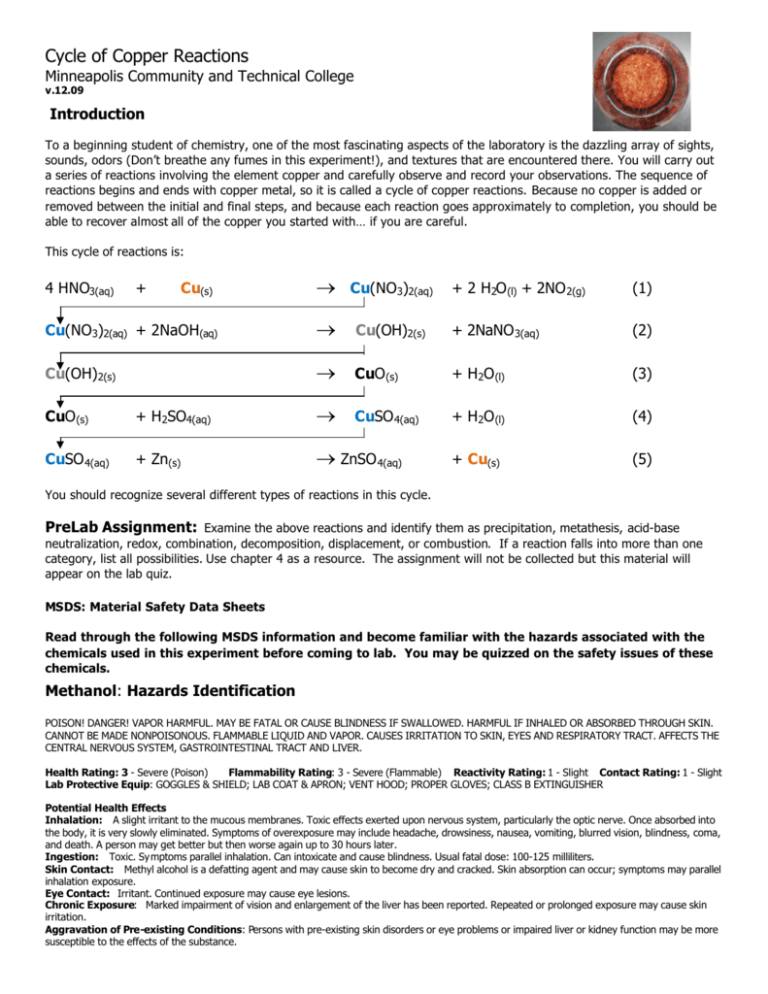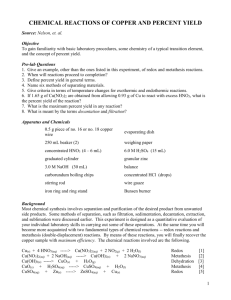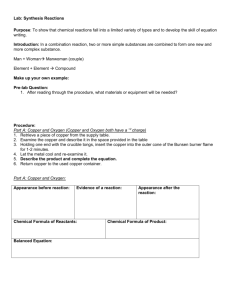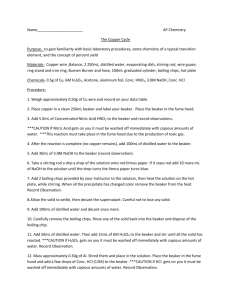12. Cycle of Copper Reactions v.12.09.docx
advertisement

Cycle of Copper Reactions Minneapolis Community and Technical College v.12.09 Introduction To a beginning student of chemistry, one of the most fascinating aspects of the laboratory is the dazzling array of sights, sounds, odors (Don’t breathe any fumes in this experiment!), and textures that are encountered there. You will carry out a series of reactions involving the element copper and carefully observe and record your observations. The sequence of reactions begins and ends with copper metal, so it is called a cycle of copper reactions. Because no copper is added or removed between the initial and final steps, and because each reaction goes approximately to completion, you should be able to recover almost all of the copper you started with… if you are careful. This cycle of reactions is: → Cu(NO3)2(aq) Cu(NO3)2(aq) + 2NaOH(aq) → Cu(OH)2(s) 4 HNO3(aq) + Cu(s) + 2 H2O (l) + 2NO 2(g) (1) Cu(OH)2(s) + 2NaNO 3(aq) (2) → CuO (s) + H2O (l) (3) CuSO 4(aq) + H2O (l) (4) + Cu(s) (5) CuO (s) + H2SO4(aq) → CuSO 4(aq) + Zn(s) → ZnSO 4(aq) You should recognize several different types of reactions in this cycle. PreLab Assignment: Examine the above reactions and identify them as precipitation, metathesis, acid-base neutralization, redox, combination, decomposition, displacement, or combustion. If a reaction falls into more than one category, list all possibilities. Use chapter 4 as a resource. The assignment will not be collected but this material will appear on the lab quiz. MSDS: Material Safety Data Sheets Read through the following MSDS information and become familiar with the hazards associated with the chemicals used in this experiment before coming to lab. You may be quizzed on the safety issues of these chemicals. Methanol: Hazards Identification POISON! DANGER! VAPOR HARMFUL. MAY BE FATAL OR CAUSE BLINDNESS IF SWALLOWED. HARMFUL IF INHALED OR ABSORBED THROUGH SKIN. CANNOT BE MADE NONPOISONOUS. FLAMMABLE LIQUID AND VAPOR. CAUSES IRRITATION TO SKIN, EYES AND RESPIRATORY TRACT. AFFECTS THE CENTRAL NERVOUS SYSTEM, GASTROINTESTINAL TRACT AND LIVER. Health Rating: 3 - Severe (Poison) Flammability Rating: 3 - Severe (Flammable) Reactivity Rating: 1 - Slight Contact Rating: 1 - Slight Lab Protective Equip: GOGGLES & SHIELD; LAB COAT & APRON; VENT HOOD; PROPER GLOVES; CLASS B EXTINGUISHER Potential Health Effects Inhalation: A slight irritant to the mucous membranes. Toxic effects exerted upon nervous system, particularly the optic nerve. Once absorbed into the body, it is very slowly eliminated. Symptoms of overexposure may include headache, drowsiness, nausea, vomiting, blurred vision, blindness, coma, and death. A person may get better but then worse again up to 30 hours later. Ingestion: Toxic. Symptoms parallel inhalation. Can intoxicate and cause blindness. Usual fatal dose: 100-125 milliliters. Skin Contact: Methyl alcohol is a defatting agent and may cause skin to become dry and cracked. Skin absorption can occur; symptoms may parallel inhalation exposure. Eye Contact: Irritant. Continued exposure may cause eye lesions. Chronic Exposure: Marked impairment of vision and enlargement of the liver has been reported. Repeated or prolonged exposure may cause skin irritation. Aggravation of Pre-existing Conditions: Persons with pre-existing skin disorders or eye problems or impaired liver or kidney function may be more susceptible to the effects of the substance. Sulfuric Acid Hazards Identification POISON! DANGER! CORROSIVE. LIQUID AND MIST CAUSE SEVERE BURNS TO ALL BODY TISSUE. MAY BE FATAL IF SWALLOWED OR CONTACTED WITH SKIN. HARMFUL IF INHALED. AFFECTS TEETH. WATER REACTIVE. CANCER HAZARD. STRONG INORGANIC ACID MISTS CONTAINING SULFURIC ACID CAN CAUSE CANCER. Risk of cancer depends on duration and level of exposure. Health Rating: 3 - Severe (Poison) Flammability Rating: 0 - None Reactivity Rating: 3 - Severe (Water Reactive) Contact Rating: 4 - Extreme (Corrosive) Lab Protective Equip: GOGGLES & SHIELD; LAB COAT & APRON; VENT HOOD; PROPER GLOVES Storage Color Code: White (Corrosive) Potential Health Effects Inhalation: Inhalation produces damaging effects on the mucous membranes and upper respiratory tract. Symptoms may include irritation of the nose and throat, and labored breathing. May cause lung edema, a medical emergency. Ingestion: Corrosive. Swallowing can cause severe burns of the mouth, throat, and stomach, leading to death. Can cause sore throat, vomiting, diarrhea. Circulatory collapse with clammy skin, weak and rapid pulse, shallow respirations, and scanty urine may follow ingestion or skin contact. Circulatory shock is often the immediate cause of death. Skin Contact: Corrosive. Symptoms of redness, pain, and severe burn can occur. Circulatory collapse with clammy skin, weak and rapid pulse, shallow respirations, and scanty urine may follow skin contact or ingestion. Circulatory shock is often the immediate cause of death. Eye Contact: Corrosive. Contact can cause blurred vision, redness, pain and severe tissue burns. Can cause blindness. Chronic Exposure: Long-term exposure to mist or vapors may cause damage to teeth. Chronic exposure to mists containing sulfuric acid is a cancer hazard. Aggravation of Pre-existing Conditions: Persons with pre-existing skin disorders or eye problems or impaired respiratory function may be more susceptible to the effects of the substance. NaOH Hazards Identification WARNING! HARMFUL IF SWALLOWED. MAY CAUSE IRRITATION TO SKIN, EYES, RESPIRATORY TRACT AND GASTROINTESTINAL TRACT. Health Rating: 2 - Moderate Flammability Rating: 0 - None Reactivity Rating: 1 - Slight Lab Protective Equip: GOGGLES; LAB COAT; VENT HOOD; PROPER GLOVES Contact Rating: 2 - Moderate The health effects from exposure to diluted forms of this chemical are not well documented. They are expected to be less severe than those for concentrated forms which are referenced in the descriptions below. Inhalation: Mists are irritants to respiratory tract. Ingestion: Corrosive. Swallowing may cause burns of the mouth, throat and stomach. Skin Contact: Can be corrosive to skin. May cause irritation. Eye Contact: Sodium Hydroxide: Corrosive! May cause irritation of eyes, and with greater exposures, severe burns with possibly blindness resulting. Chronic Exposure: Prolonged contact can dehydrate and remove oils from skin. Aggravation of Pre-existing Conditions: Persons with pre-existing skin disorders may be susceptible to these solutions. Procedure: Cycle of Copper Safety Notes: • You will be working in the fume hood for all parts of today’s experiment. • A squeeze pipette can be useful for transferring the HNO3 from a small beaker to your 10-ml graduated cylinder. Wash your hands after handling HNO3. • The dissolution of the copper with concentrated HNO3 should be carried out in a fume hood. The brown NO2 gas that is evolved is TOXIC and must be avoided. • NaOH solutions are corrosive to the skin and especially dangerous if splashed into the eyes—wear your safety glasses. • Methanol is flammable and its vapors are toxic. Use in the hood to avoid breathing the vapor, and keep away from all open flames. • WASTE COLLECTION: It is both better for the environment and less expensive to MCTC if we collect waste products in separate containers. Please note the following two waste products require special attention. o The solution you pour off in Step 5 contains zinc sulfate and will be collected in a separate waste container. o The used methanol from Step 5 is also collected separately. Look for a used methanol container in the lab. 1. Reaction: 4 HNO3(aq) + → Cu(s) Cu(NO3)2(aq) + 2 H2O(l) + 2NO2(g) Obtain a pure copper wire ball that weighs about 0.5 g. If it is not bright and shiny, exchange it with one that is. Weigh the copper wire ball to the nearest 0.1 milligram using an analytical balance. Place it in the bottom of a 250mL beaker. Add ~4.0 mL of concentrated (16 M) nitric acid, HNO3. This amount of nitric acid will be in excess of what’s actually needed for the reaction. Continue working in the hood and gently swirl the solution in the beaker until the copper has completely dissolved. After the copper has dissolved, carefully add distilled water until the beaker is about half full. (Note: In almost all cases, acid is added to water. However, such precautions are not necessary in this experiment.) Record your observations and answers to questions on the data sheet. 2. Reaction: Cu(NO3)2(aq)+ 2NaOH(aq) → Cu(OH)2(s) + 2NaNO3(aq) While stirring the solution with a glass rod, add 30 mL of 3.0 M NaOH to precipitate out the Cu(OH) 2. This amount of sodium hydroxide will be in excess of what’s actually needed for the reaction. Record your observations and answers to questions on the data sheet. 3. Reaction: Cu(OH)2(s) + heat → CuO(s) + H2O(l) Preheat ~ 200 mL distilled water in a separate beaker using a hotplate (350 degrees). While continuously stirring, warm your solution on the same hotplate just short of its boiling point. Stir constantly with your glass stirring rod to avoid bumping (formation of large, uncontrollable boiling bubbles) Don’t forget to stir using your glass stirring rod! When the reaction is complete, remove the beaker from the hot plate, continue stirring for a minute or so, and then allow the CuO to settle. If the CuO doesn’t settle significantly, re-heat and stir the mixture for 3-5 more minutes and try again. Then decant (pour off) the supernatant liquid. Try to keep CuO loss to a minimum. ADD ABOUT 200mL of HOT DISTILLED WATER (don’t burn your fingers!), allow the solid to settle again, and decant once more. 4. Reaction: CuO(s) + H2SO4(aq) → CuSO4(aq) + H2O(l) While stirring, add 15 mL of 6 M H2SO4, to the CuO. Transfer the resulting solution into a 100 or 150 mL beaker. Record your observations and answers to questions on the data sheet. 5. Reaction: CuSO4(aq) + Zn(s) → ZnSO4(aq) + Cu(s) In the fume hood, add 2.0 - 2.1 g of granulated zinc metal all at once and stir until the supernatant liquid is colorless and all of the Zn is consumed. (Record Observations) Pre-weigh a dry evaporating dish (figure at right) on the analytical balance. Decant the supernatant liquid into the waste container provided and transfer the copper to the evaporating dish. A spatula or rubber policeman is helpful when making this material transfer. Wash the copper product with about 5 mL of distilled water, allow it to settle, and decant the wash water into the Zn solution waste container provided. Repeat washing /decanting at least two more times. Now wash the solid with approximately 5 mL of methanol from a squirt bottle. Allow the solid to settle, and decant. Dispose of the methanol in the methanol recovery container. Repeat the methanol washing step a second time. Place the evaporating dish on your hot plate (150 degrees). The methanol will quickly evaporate leaving you with dry copper metal. Hint: Position the hotplate at the rear of the hood to keep drafts from cooling the dish/product during the drying process. When the copper is properly dried (…think dry beach sand), let the evaporating dish cool and re-weigh it on the analytical balance. C1151 Data Sheet Cycle of Copper Reactions Instructor Initials_____ Name_________________________ Date of Exp. ________________ Lab Section ________________ Your individual experimental report will be due at the beginning of class next week. Observations: Record your observations and the answers to all questions in the space provided. Reaction #1: 4 HNO3(aq) + Copper Mass → Cu(s) Cu(NO3)2(aq) + 2 H2O(l) + 2NO2(g) = _____________ Observations: _________________________________________________________________________________________ _________________________________________________________________________________________ _________________________________________________________________________________________ Question: How did you know the reaction was complete? _________________________________________________________________________________________ _________________________________________________________________________________________ Question: List all ionic species present in the solution when the reaction is complete. _________________________________________________________________________________________ Reaction #2: → Cu(NO3)2(aq) + 2NaOH(aq) Cu(OH)2(s) + 2NaNO3(aq) Observations: _________________________________________________________________________________________ _________________________________________________________________________________________ _________________________________________________________________________________________ _________________________________________________________________________________________ Question: What is formed in the solution besides Cu(OH) 2 and NaNO3? _________________________________________________________________________________________ _________________________________________________________________________________________ Reaction #3: Cu(OH)2(s) + heat → CuO(s) + H2O(l) Observations: _________________________________________________________________________________________ _________________________________________________________________________________________ _________________________________________________________________________________________ Question: What compounds does the washing and decantation process remove? ________________________________________________________________________________________ _________________________________________________________________________________________ Reaction #4: CuO(s) + H2SO4(aq) → CuSO4(aq) + H2O(l) Observations: _________________________________________________________________________________________ _________________________________________________________________________________________ _________________________________________________________________________________________ _________________________________________________________________________________________ _________________________________________________________________________________________ _________________________________________________________________________________________ Question: What in the solution can we attribute its color? _________________________________________________________________________________________ Reaction #5: CuSO4(aq) + Zn(s) → ZnSO4(aq) Empty Evaporating Dish Mass = _____________ Evaporating Dish + Product Mass = _____________ Product Mass = _____________ + Cu(s) Observations: _________________________________________________________________________________________ _________________________________________________________________________________________ _________________________________________________________________________________________ _________________________________________________________________________________________ _________________________________________________________________________________________ _________________________________________________________________________________________ Follow-up Questions: 1. Reaction #1 is an oxidation-reduction reaction. Re-write the reaction below and include the oxidation numbers for each element What is the oxidizing agent?_____________________ What is the reducing agent?_____________________ 2. You should have noticed a gas being produced by reaction #5. Since there are no gaseous products predicted by reaction #5, there must be another chemical reaction occurring at the same time. What is the identity and chemical formula of this combustible gas? __________________ In the space below, write the complete chemical reaction that is responsible for the gas formation: 4. Determine the % Recovery via the following formula: (Show work) % Recovery = Mass of recovered copper Initial mass of copper x 100 5. Very rarely will 100% of the original copper be recovered. a. Cite two specific times you know material was being lost while performing the experiment. i. ii. b. If a student claims to mistakenly have greater than 100% yield, what could be the problem? (Don’t include operator error or calculation mistakes as part of your answer)





